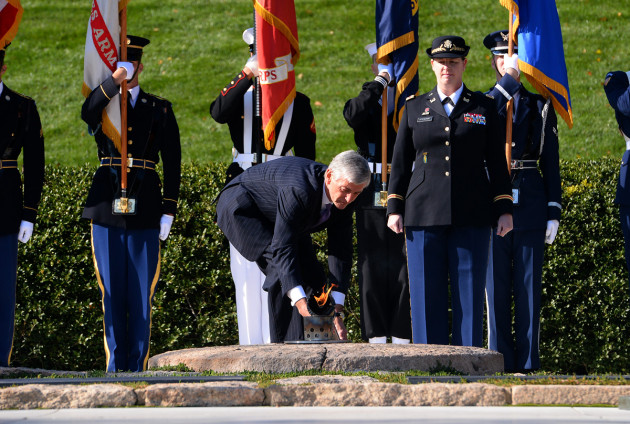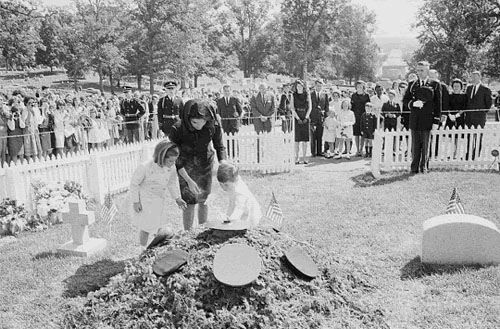If you were around for the assassination of President Kennedy, and especially if you were a 9-year-old kid, you may find conflicting feelings about the 50th anniversary.
First of all, of course, it’s a reminder that you’re old. Defining moments always seem like yesterday, but the assassination is as long ago now as the election of Woodrow Wilson was back then.
There’ll be plenty of overwritten news stories about the assassination ending our innocence and all, but we know now that we as a nation didn’t really have any innocence to lose.
Over time, the assassination has lost some of its significance. That seemed clear, at least to me today, when this took place.

The “eternal flame” at Kennedy’s grave site at Arlington National Cemetery was lit again after some infrastructure work on the fuel lines at the grave site were completed. The flame had been stored in a temporary container.
Nothing against Secretary of the Army John McHugh, who did the honors, but there was a time when Kennedy grave ceremonies and moments were too big for the likes of a mere secretary of the Army.
But it makes sense, since an Army engineer is responsible for it. There had never been anything like an eternal flame in the cemetery before and the man who came up with the system for it — Col. Clayton Lyle — had less than a day to invent it at the request of Mrs. Kennedy.
According to “A Treasury of Texas Tales”
There was no time to carefully design and plan such a device. He and his staff had to make do from scratch. Scrounging Washington’s electrical shops, they found a “luau lamp” normally used to illuminate garden parties. They tested it by dousing it with water, blasting it with air, and trying everything they could think of to kill the flame. It continued to burn.
Meanwhile, Lyle’s crew of officers and men at Fort Belvoir, Virginia, made a base for the lamp by welding metal strips into a support frame. With the lamp and its base a reality, finding fuel posed a problem. It was a Sunday and propane gas suppliers were closed. After dozens of telephone calls, personnel at Fort Myer, Virginia, which adjoins Arlington National Cemetery, finally reached a company that could furnish the propane.
Working around the clock, Fort Myer officers and men laid a one-inch line down the hillside to deliver gas to the burial site. Thirty hours and a sleepless night after General Wilson’s call, the project was complete. Now the only concern of Lyle and his crew was whether or not the flame would light when Mrs. Kennedy ignited it at the conclusion of the service.
Colonel Lyle and a fellow officer stood on the hillside above the grave and watched.
“We had tested how long it took the gas to get down the line once it was turned on,” he recalls. “At the right moment, we signaled a man at the tank to turn it on. It worked.”
As millions watched on television, Mrs. Kennedy took a burning taper from her military escort. When she touched the lamp, the flame leaped up just as Lyle had hoped, and believed, it would.
Colonel Lyle has always regretted that the eternal flame he designed and built was necessarily a makeshift project that would have to be replaced with a permanent device later. His original lasted for more than a year, however, with only one interruption. That happened about a month after the funeral when he got a phone call from General Wilson.
“You didn’t test it for one thing—holy water!” his boss told him.
It seems that a Catholic school group came to visit the grave. Instead of sprinkling the consecrated water, they poured it directly on the flame. It went out. Fortunately, one of the guards at the grave was a smoker. He used his cigarette lighter to get it restarted.

